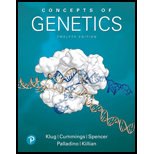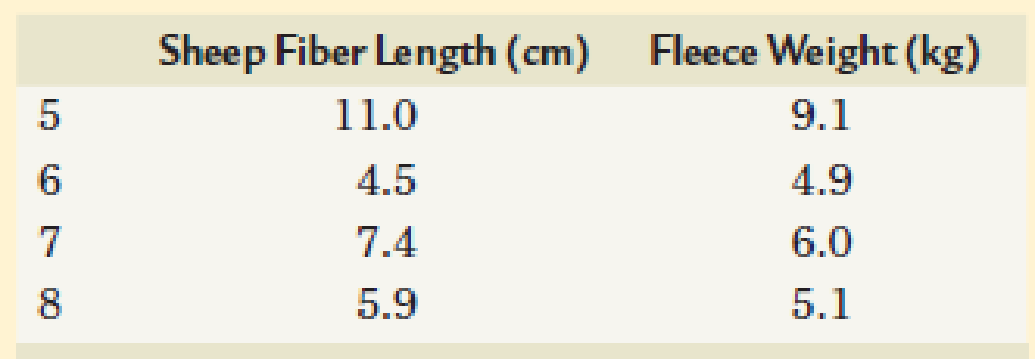
Concepts of Genetics Plus Mastering Genetics with Pearson eText -- Access Card Package (12th Edition) (What's New in Genetics)
12th Edition
ISBN: 9780134811390
Author: William S. Klug, Michael R. Cummings, Charlotte A. Spencer, Michael A. Palladino, Darrell Killian
Publisher: PEARSON
expand_more
expand_more
format_list_bulleted
Concept explainers
Textbook Question
Chapter 25, Problem 2NST
The following table shows measurements for fiber lengths and fleece weight in a small flock of eight sheep.


- (a) What are the mean, variance, and standard deviation for each trait in this flock?
- (b) What is the covariance of the two traits?
- (c) What is the
correlation coefficient for fiber length and fleece weight? - (d) Do you think greater fleece weight is correlated with an increase in fiber length? Why or why not?
■ This problem provides data for two quantitative traits in a flock of sheep. After making numerous statistical calculations, you are asked in part (d) to determine if the traits are correlated.
Expert Solution & Answer
Want to see the full answer?
Check out a sample textbook solution
Students have asked these similar questions
Diagram of check cell under low power and high power
a couple in which the father has the a blood type and the mother has the o blood type produce an offspring with the o blood type, how does this happen? how could two functionally O parents produce an offspring that has the a blood type?
What is the opening indicated by the pointer? (leaf x.s.)
stomate
guard cell
lenticel
intercellular space
none of these
Chapter 25 Solutions
Concepts of Genetics Plus Mastering Genetics with Pearson eText -- Access Card Package (12th Edition) (What's New in Genetics)
Ch. 25 - A homozygous plant with 20-cm-diameter flowers is...Ch. 25 - The following table shows measurements for fiber...Ch. 25 - The following cable gives the percentage of twin...Ch. 25 - At an interview with a genetic counselor, a couple...Ch. 25 - Prob. 2CSCh. 25 - At an interview with a genetic counselor, a couple...Ch. 25 - HOW DO WE KNOW? In this chapter, we focused on a...Ch. 25 - CONCEPT QUESTION Review the Chapter Concepts list...Ch. 25 - Define the following: (a) polygenic, (b) additive...Ch. 25 - A dark-red strain and a white strain of wheat are...
Ch. 25 - Height in humans depends on the additive action of...Ch. 25 - An inbred strain of plants has a mean height of 24...Ch. 25 - Erma and Harvey were a compatible barnyard pair,...Ch. 25 - In the following table, average differences of...Ch. 25 - What kind of heritability estimates (broad sense...Ch. 25 - List as many human traits as you can that are...Ch. 25 - Corn plants from a test plot are measured, and the...Ch. 25 - The following variances were calculated for two...Ch. 25 - The mean and variance of plant height of two...Ch. 25 - Prob. 14PDQCh. 25 - Prob. 15PDQCh. 25 - In an assessment of learning in Drosophila, flies...Ch. 25 - Prob. 17PDQCh. 25 - Prob. 18PDQCh. 25 - In a population of 100 inbred, genotypically...Ch. 25 - Many traits of economic or medical significance...Ch. 25 - A 3-inch plant was crossed with a 15-inch plant,...Ch. 25 - In a cross between a strain of large guinea pigs...Ch. 25 - Type A1B brachydactyly (short middle phalanges) is...Ch. 25 - In a series of crosses between two true-breeding...Ch. 25 - Students in a genetics laboratory began an...Ch. 25 - Prob. 26ESPCh. 25 - Canine hip dysplasia is a quantitative trait that...Ch. 25 - Floral traits in plants often play key roles in...Ch. 25 - In 1988, Horst Wilkens investigated blind...
Knowledge Booster
Learn more about
Need a deep-dive on the concept behind this application? Look no further. Learn more about this topic, biology and related others by exploring similar questions and additional content below.Similar questions
- Identify the indicated tissue? (stem x.s.) parenchyma collenchyma sclerenchyma ○ xylem ○ phloem none of thesearrow_forwardWhere did this structure originate from? (Salix branch root) epidermis cortex endodermis pericycle vascular cylinderarrow_forwardIdentify the indicated tissue. (Tilia stem x.s.) parenchyma collenchyma sclerenchyma xylem phloem none of thesearrow_forward
- Identify the indicated structure. (Cucurbita stem l.s.) pit lenticel stomate tendril none of thesearrow_forwardIdentify the specific cell? (Zebrina leaf peel) vessel element sieve element companion cell tracheid guard cell subsidiary cell none of thesearrow_forwardWhat type of cells flank the opening on either side? (leaf x.s.) vessel elements sieve elements companion cells tracheids guard cells none of thesearrow_forward
- What specific cell is indicated. (Cucurbita stem I.s.) vessel element sieve element O companion cell tracheid guard cell none of thesearrow_forwardWhat specific cell is indicated? (Aristolochia stem x.s.) vessel element sieve element ○ companion cell O O O O O tracheid O guard cell none of thesearrow_forwardIdentify the tissue. parenchyma collenchyma sclerenchyma ○ xylem O phloem O none of thesearrow_forward
- Please answer q3arrow_forwardRespond to the following in a minimum of 175 words: How might CRISPR-Cas 9 be used in research or, eventually, therapeutically in patients? What are some potential ethical issues associated with using this technology? Do the advantages of using this technology outweigh the disadvantages (or vice versa)? Explain your position.arrow_forwardYou are studying the effect of directional selection on body height in three populations (graphs a, b, and c below). (a) What is the selection differential? Show your calculation. (2 pts) (b) Which population has the highest narrow sense heritability for height? Explain your answer. (2 pts) (c) If you examined the offspring in the next generation in each population, which population would have the highest mean height? Why? (2 pts) (a) Midoffspring height (average height of offspring) Short Short Short Short (c) Short (b) Short Tall Short Tall Short Short Tall Midparent height (average height of Mean of population = 65 inches Mean of breading parents = 70 inches Mean of population = 65 inches Mean of breading parents = 70 inches Mean of population = 65 inches Mean of breading parents = 70 inchesarrow_forward
arrow_back_ios
SEE MORE QUESTIONS
arrow_forward_ios
Recommended textbooks for you
 Human Heredity: Principles and Issues (MindTap Co...BiologyISBN:9781305251052Author:Michael CummingsPublisher:Cengage Learning
Human Heredity: Principles and Issues (MindTap Co...BiologyISBN:9781305251052Author:Michael CummingsPublisher:Cengage Learning Concepts of BiologyBiologyISBN:9781938168116Author:Samantha Fowler, Rebecca Roush, James WisePublisher:OpenStax College
Concepts of BiologyBiologyISBN:9781938168116Author:Samantha Fowler, Rebecca Roush, James WisePublisher:OpenStax College Biology: The Dynamic Science (MindTap Course List)BiologyISBN:9781305389892Author:Peter J. Russell, Paul E. Hertz, Beverly McMillanPublisher:Cengage Learning
Biology: The Dynamic Science (MindTap Course List)BiologyISBN:9781305389892Author:Peter J. Russell, Paul E. Hertz, Beverly McMillanPublisher:Cengage Learning

Human Heredity: Principles and Issues (MindTap Co...
Biology
ISBN:9781305251052
Author:Michael Cummings
Publisher:Cengage Learning




Concepts of Biology
Biology
ISBN:9781938168116
Author:Samantha Fowler, Rebecca Roush, James Wise
Publisher:OpenStax College

Biology: The Dynamic Science (MindTap Course List)
Biology
ISBN:9781305389892
Author:Peter J. Russell, Paul E. Hertz, Beverly McMillan
Publisher:Cengage Learning
Genetic Variation and Mutation | 9-1 GCSE Science Biology | OCR, AQA, Edexcel; Author: SnapRevise;https://www.youtube.com/watch?v=bLP8udGGfHU;License: Standard YouTube License, CC-BY